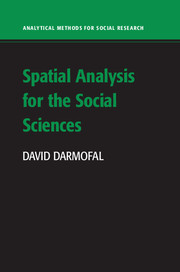Book contents
- Frontmatter
- Contents
- List of Figures
- List of Tables
- Preface
- PART I GENERAL TOPICS
- PART II ADVANCED TOPICS
- PART III APPENDICES ON IMPLEMENTING SPATIAL ANALYSES
- Appendix A Getting Data Ready for a Spatial Analysis
- Appendix B Spatial Software
- Appendix C Web Resources for Spatial Analysis
- Glossary
- Bibliography
- Index
Appendix A - Getting Data Ready for a Spatial Analysis
from PART III - APPENDICES ON IMPLEMENTING SPATIAL ANALYSES
Published online by Cambridge University Press: 05 November 2015
- Frontmatter
- Contents
- List of Figures
- List of Tables
- Preface
- PART I GENERAL TOPICS
- PART II ADVANCED TOPICS
- PART III APPENDICES ON IMPLEMENTING SPATIAL ANALYSES
- Appendix A Getting Data Ready for a Spatial Analysis
- Appendix B Spatial Software
- Appendix C Web Resources for Spatial Analysis
- Glossary
- Bibliography
- Index
Summary
Spatial data require some minimal work at the early stages of analysis to get these data ready for a spatial analysis. This work is not onerous and can typically be completed in just a few minutes. However, the steps in this work are unique to spatial data and many researchers in the social sciences are not familiar with these steps. As a consequence, it is useful to briefly discuss them. Researchers interested in exploring the details of these steps will find additional, detailed information on them in manuals for geographic information systems (GIS) and other software.
The main issue in setting up data for a spatial analysis is that datasets in the social sciences do not include geometric information on the units the researcher is seeking to examine. To be sure, these data do typically include identifiers and use of these geographic identifiers, such as Federal Information Processing Standards (FIPS) codes, is very helpful in linking social science data up to files that contain features of the polygons examined, such as their size, boundaries, and locations. But typically, social science data do not include these latter features themselves, and thus researchers must link, or join, their datasets to a file that contains this information.
The standard such geographic file in spatial analysis is the shapefile developed by Environmental Systems Research Institute (ESRI) for use with its Arcview GIS software in the early 1990s. Today, ESRI's principal GIS product is ArcGIS, which includes a suite of component applications, including ArcMap, ArcCatalog, ArcScene, and ArcGlobe. One of the more efficient ways to join one's data is to do so in ArcMap, utilizing an identifier variable that is included in both the shapefile and in the researcher's dataset. Often this variable will be the units’ FIPS codes.
Shapefiles are readily available for a variety of polygons of interest via the Internet. Many colleges and universities have GIS units on campus that can aid researchers in finding shapefiles if a search on theWeb proves unsuccessful.
- Type
- Chapter
- Information
- Spatial Analysis for the Social Sciences , pp. 207 - 208Publisher: Cambridge University PressPrint publication year: 2015

